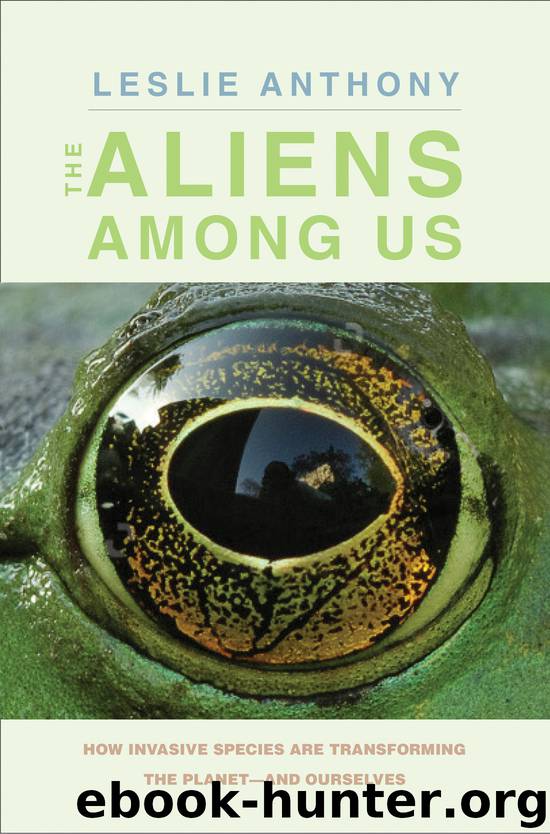The Aliens Among Us by Leslie Anthony

Author:Leslie Anthony
Language: eng
Format: epub
ISBN: 9780300231618
Publisher: Yale University Press
Moose Crossing
While invasive moose made a mess of Newfoundland, the species was paradoxically experiencing steep declines elsewhere in North America. What was happening varied according to location, but even in areas of relative abundance or natural increase, signs pointed to imminent collapse. By 2013, alarming declines were seen in all provinces from Quebec westward, and several northern U.S. states. Although the answer to “Why?” wasn’t entirely clear, like most other animals in decline it appeared to be a variety of factors—disease, predation, and climate change chief among them. And you didn’t need to look far into that troika to find an odd connection: propelled by climate change and other factors, deer were overpopulating and expanding their range everywhere, spreading disease to moose and increasing the abundance of predators affecting them.
In Minnesota, for instance, 40 percent of adult moose were dying from brain worm (Parelaphostrongylus tenuis), a tiny parasite transmitted by deer. An additional 20 percent were dying from higher-than-normal winter tick loads, and a final 20 percent from a combination of stressors. In Canada’s Jasper National Park, moose decline was attributed to the deadly giant liver fluke (Fascioloides magna), more wolves, and continued—albeit reduced—collisions on the railways and highways traversing the park. Another emerging problem was decreasing calf survival. In Minnesota’s Grand Portage Trust Lands, for instance, 90 percent of moose calves died each year—75 percent lost to predation during the first weeks of life, the remaining 15 percent to subsequent health issues.
Though brain worm doesn’t affect its deer carriers (it lives benignly in the connective tissue around a deer’s brain and spinal cord), the parasite has a typically complex life cycle: the worms release eggs that hatch in the deer’s lungs; after being coughed up, swallowed, and excreted, the larvae find homes in snails and slugs. By accidentally consuming these mollusks while grazing, 90 percent of all deer are infected in their first two years of life. In areas of deer abundance, moose pick up the worm, too. But brain worm isn’t happy in moose: it just burrows around looking for a whitetail deer brain that it never finds. Not only is the moose a dead-end host, it also usually ends up dead. (On Lake Superior’s Isle Royale—free of deer and thus brain worm—the trend is opposite: collapse of the wolf population from inbreeding sent moose numbers soaring. As on predator-free Newfoundland and Anticosti, the moose irruption now threatens to exceed carrying capacity by wiping out its main food, balsam fir, another example of why predators are critical to ecosystem health.)
Ditto for winter tick (Dermacentor albipictus), another devastating pest moved around by fellow cervids like deer and elk. Larval ticks climb onto moose in the fall and feed themselves into adulthood over the winter. Moose with particularly heavy loads—over 100,000 ticks were counted on one decidedly miserable animal—simply can’t eat enough to replace the blood loss, and end up cannibalizing their own muscle tissue for protein before, inevitably, dying.
Despite proximal parasite problems, however, the underlying cause of moose declines
Download
This site does not store any files on its server. We only index and link to content provided by other sites. Please contact the content providers to delete copyright contents if any and email us, we'll remove relevant links or contents immediately.
Sapiens: A Brief History of Humankind by Yuval Noah Harari(14308)
The Tidewater Tales by John Barth(12623)
Mastermind: How to Think Like Sherlock Holmes by Maria Konnikova(7272)
Do No Harm Stories of Life, Death and Brain Surgery by Henry Marsh(6903)
The Thirst by Nesbo Jo(6871)
Why We Sleep: Unlocking the Power of Sleep and Dreams by Matthew Walker(6648)
Life 3.0: Being Human in the Age of Artificial Intelligence by Tegmark Max(5504)
Sapiens by Yuval Noah Harari(5316)
The Longevity Diet by Valter Longo(5036)
The Body: A Guide for Occupants by Bill Bryson(5023)
The Rules Do Not Apply by Ariel Levy(4904)
The Immortal Life of Henrietta Lacks by Rebecca Skloot(4546)
Animal Frequency by Melissa Alvarez(4422)
Why We Sleep by Matthew Walker(4388)
The Hacking of the American Mind by Robert H. Lustig(4333)
Yoga Anatomy by Kaminoff Leslie(4329)
All Creatures Great and Small by James Herriot(4266)
Double Down (Diary of a Wimpy Kid Book 11) by Jeff Kinney(4237)
Embedded Programming with Modern C++ Cookbook by Igor Viarheichyk(4134)
